Key project partners
Memoranda of agreement and workplans that formalize engagement in the international maize research and development agenda have been established with hundreds of partners (see Partner Institutions). They also have been built upon detailed workplans mostly within highly multidisciplinary and multi-institutional projects such as:
- CSISA
- DTMA
- EGSP
- FACASI
- HarvestPlus
- HMRP
- HTMA
- IMAS
- IRMA
- ISMA
- MasAgro
- NuME
- SARD-SC
- SIMLESA
- SIMLEZA
- WEMA
The Cereal Systems Initiative for South Asia (CSISA)
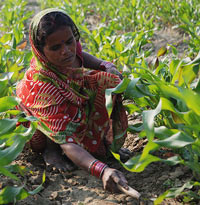 Funded by the Bill & Melinda Gates Foundation and the U.S. Agency for International Development (USAID), CSISA was established in 2009 to promote durable change at scale in South Asia’s cereal-based cropping systems. CSISA supports regional and national efforts to improve cereal production growth in South Asia’s Indo-Gangetic Plains, home to the region’s most important grain baskets. Operating in rural “innovation hubs” in Bangladesh, India and Nepal, CSISA involves more than 300 public, civil society and private sector partners in the development and dissemination of improved cropping systems, resource-conserving management technologies, new cereal varieties and hybrids, livestock feeding strategies and feed value chains, aquaculture systems, and policies and markets. In essence, CSISA is an innovation systems platform that links a wide range of public, private and civil society sector programs within and across South Asia.
Funded by the Bill & Melinda Gates Foundation and the U.S. Agency for International Development (USAID), CSISA was established in 2009 to promote durable change at scale in South Asia’s cereal-based cropping systems. CSISA supports regional and national efforts to improve cereal production growth in South Asia’s Indo-Gangetic Plains, home to the region’s most important grain baskets. Operating in rural “innovation hubs” in Bangladesh, India and Nepal, CSISA involves more than 300 public, civil society and private sector partners in the development and dissemination of improved cropping systems, resource-conserving management technologies, new cereal varieties and hybrids, livestock feeding strategies and feed value chains, aquaculture systems, and policies and markets. In essence, CSISA is an innovation systems platform that links a wide range of public, private and civil society sector programs within and across South Asia.Drought Tolerant Maize for Africa (DTMA)
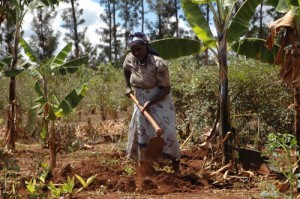
Launched in 2006, the DTMA project is funded by the Bill & Melinda Gates Foundation, the Howard G. Buffett Foundation, USAID and the UK Department for International Development (DFID). CIMMYT and the International Institute of Tropical Agriculture (IITA) coordinate work with publicly funded research organizations, public and private seed producers, varietal certification agencies and farmer groups in 13 countries: Angola, Benin, Ethiopia, Ghana, Kenya, Malawi, Mali, Mozambique, Nigeria, Tanzania, Uganda, Zambia and Zimbabwe. Farmers in those countries have access to seed of 34 drought-tolerant varieties and hybrids. In addition to drought tolerance, maize from the project is bred for local adaptation, including traits such as superior milling or cooking quality and resistance to regionally important diseases (maize streak virus, turcicum leaf blight, gray leaf spot). The project builds on more than two decades of visionary research and support (see list of donors below). DFID won a 2012 UK Climate Week Award (Best Technological Breakthrough) for its support of DTMA.
Effective Grain Storage for Better Livelihood of African Farmers (EGSP)
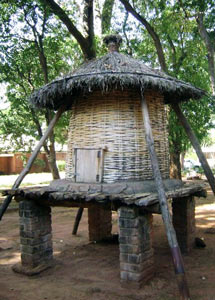 From Phase I of the EGSP, implemented from 2008 to 2010 and funded by the Swiss Agency for Development and Cooperation (SDC), the metal silo technology has proved effective in protecting harvested grains from attack from destructive insects such as the larger grain borer (LGB) and maize weevil (MW). In addition, considerable progress and achievements have been made during the last four years including the role of other factors in improving the post-harvest systems in the region – economics of metal silos and other storage methods, value chains for production and supply of metal silos, markets for surplus produce, identification and formation of alliance with partners, information and awareness creation, training artisans and instructors.
From Phase I of the EGSP, implemented from 2008 to 2010 and funded by the Swiss Agency for Development and Cooperation (SDC), the metal silo technology has proved effective in protecting harvested grains from attack from destructive insects such as the larger grain borer (LGB) and maize weevil (MW). In addition, considerable progress and achievements have been made during the last four years including the role of other factors in improving the post-harvest systems in the region – economics of metal silos and other storage methods, value chains for production and supply of metal silos, markets for surplus produce, identification and formation of alliance with partners, information and awareness creation, training artisans and instructors.The project specifically focuses on four selected East and Southern African (ESA) countries (Kenya, Malawi, Zambia and Zimbabwe) that have high vulnerability to post-harvest insects.
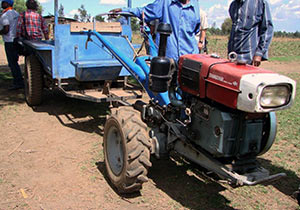 Farm Mechanization and Conservation Agriculture for Sustainable Intensification (FACASI)
Farm Mechanization and Conservation Agriculture for Sustainable Intensification (FACASI)Funded by the Australian International Food security Centre (AIFSC), led by CIMMYT and implemented by 11 partners from public institutions, universities, national agricultural research institutes and international agricultural research organizations, the FACASI project is working with smallholder farmers in Sub-Saharan Africa to deliver small-scale mechanization based on inexpensive, two-wheel tractors and introducing power-saving technologies such as conservation agriculture.
The aim of this project is to improve farming practices (such as planting, harvesting, milling and transporting), and the commercial mechanisms needed to deliver these to smallholder farmers. The project is identifying opportunities to create new markets for equipment and services, and supporting policies and networks in Ethiopia, Kenya, Tanzania and Zimbabwe.
HarvestPlus

HarvestPlus seeks to reduce hidden hunger and provide micronutrients to billions of people directly through the staple foods that they eat. It uses a novel process called biofortification to breed higher levels of micronutrients directly into key staple foods.
HarvestPlus focuses on three critical micronutrients that are recognized by the World Health Organization (WHO) as most limiting in diets: iron, zinc and vitamin A. HarvestPlus envisions that in 15 years, millions of people suffering from micronutrient malnutrition will be eating new biofortified crop varieties.
With funding from the Bill & Melinda Gates Foundation and from many other generous donors, HarvestPlus is now a part of the CGIAR Research Program on Agriculture for Nutrition and Health (A4NH) to which MAIZE contributes.
Hill Maize Research Project (HMRP)
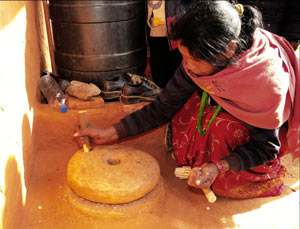 Funded by the Swiss Agency for Development and Cooperation (SDC) and the U.S. Agency for International Development (USAID), HMRP was initiated in 1999 to increase the food security of farm families in the hills of Nepal by raising the productivity and sustainability of maize-based cropping systems. The HMRP went through three phases between 1999 and 2010, and the fourth phase began implementation in August 2010.
Funded by the Swiss Agency for Development and Cooperation (SDC) and the U.S. Agency for International Development (USAID), HMRP was initiated in 1999 to increase the food security of farm families in the hills of Nepal by raising the productivity and sustainability of maize-based cropping systems. The HMRP went through three phases between 1999 and 2010, and the fourth phase began implementation in August 2010.Overall, the project has placed emphasis in the validation and dissemination of improved maize technologies, varietal development, participatory approaches for technology adoption and strengthened partnership with local stakeholders.
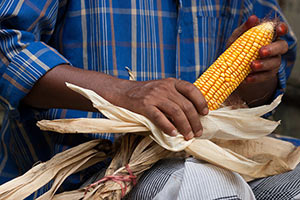 Heat Tolerant Maize for Asia (HTMA)
Heat Tolerant Maize for Asia (HTMA)South Asian farm lands have been increasingly experiencing climate change-related weather extremes. A report from the Asian Development Bank in 2009 warns that if the current trends persist until 2050, major crop yields and food production capacity of South Asia will significantly decrease - by 17 percent for maize, 12 percent for wheat and 10 percent for rice - due to climate change-induced heat and water stress. In response to this situation, USAID’s Feed the Future (FTF) initiative has decided to support the “Heat stress resilient maize for South Asia through a public-private partnership” (Heat Tolerant Maize for Asia, HTMA) project to develop heat-resilient maize for South Asia.
Launched in Januray 2013, HTMA is a public-private CIMMYT-led alliance consisting of Purdue University, Pioneer Hi-Bred, seed companies and South Asian public sector maize programs. It targets resource-poor people of South Asia who rely on growing maize for subsistence or income in rainfed conditions, and whose welfare is directly dependent on maize yields and negatively affected by crop failures.
Improved Maize for African Soils Project (IMAS)
 Launched in February 2010, the Improved Maize for African Soils Project (IMAS) is developing maize varieties that are better at capturing the small amount of fertilizer that African farmers can afford, and that use the nitrogen they take up more efficiently to produce grain. Project participants are using cutting-edge biotechnology tools such as molecular markers - DNA "signposts" for traits of interest - and transgenic approaches to develop varieties that ultimately yield 30 to 50 percent more than currently available varieties, with the same amount of nitrogen fertilizer applied or when grown on poorer soils.
Launched in February 2010, the Improved Maize for African Soils Project (IMAS) is developing maize varieties that are better at capturing the small amount of fertilizer that African farmers can afford, and that use the nitrogen they take up more efficiently to produce grain. Project participants are using cutting-edge biotechnology tools such as molecular markers - DNA "signposts" for traits of interest - and transgenic approaches to develop varieties that ultimately yield 30 to 50 percent more than currently available varieties, with the same amount of nitrogen fertilizer applied or when grown on poorer soils.IMAS is being led by CIMMYT and funded by the Bill & Melinda Gates Foundation and USAID. The project's other partners - the DuPont Business, Pioneer Hi-Bred, the Kenya Agricultural Research Institute (KARI), and the South African Agricultural Research Council (ARC) - are also providing significant in-kind contributions including staff, infrastructure, seed, traits, technology, training and know-how.
Insect Resistant Maize for Africa (IRMA)
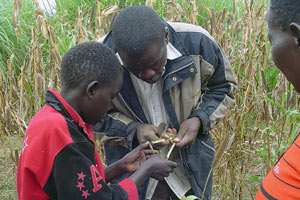 This project has been supporting resource-poor farmers to increase their maize crop yield and reduce the loss from storage pests. Currently in its third phase, the project’s formal title is:
This project has been supporting resource-poor farmers to increase their maize crop yield and reduce the loss from storage pests. Currently in its third phase, the project’s formal title is:‘Developing Maize Resistant to Stem Borer and Storage Insect Pests for Eastern and Southern Africa - IRMA III Conventional (2009-2013).’
Running from 2009-2013, this phase is funded by the Syngenta Foundation for Sustainable Agriculture, and focuses on developing and deploying conventional maize that is resistant to field and storage insect pests, for East and Southern Africa (ESA).
The countries targeted in this phase of the project are Ethiopia, Kenya, Malawi, Mozambique, Tanzania, Uganda, Zambia and Zimbabwe.
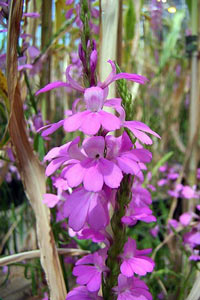 Integrated Striga Management in Africa (ISMA)
Integrated Striga Management in Africa (ISMA)Funded by the Bill & Melinda Gates Foundation, ISMA, led by the International Institute of Tropical Agriculture (IITA) is adapting and intensively promoting proven integrated Striga control strategies in two pilot countries, Nigeria and Kenya, with the active participation of farmers, community-based organizations, extension workers, policymakers and researchers. The project is supplying parental lines, hybrids and open-pollinated varieties of maize as well as legume trap crops to private seed companies and community-based seed producers for production, distribution and marketing.
Among the many species of Striga, S. hermonthica is the most widespread, affecting cereals (with maize being the most susceptible). It is estimated to have caused yield losses in maize of 30 to 80 percent valued at US$383 million to US$1 billion and negatively affecting the livelihoods of about 100 million people in Sub-Saharan Africa.
CIMMYT, the International Center for Insect Physiology and Ecology (icipe), the African Agricultural Technology Foundation (AATF) and BASF Crop Protection are partnering to achieve sustainable Striga control for poor farmers.
Sustainable Modernization of the Traditional Agriculture (MasAgro)
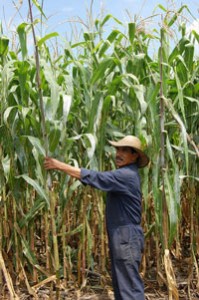 More than 100 national and international organizations are involved in agricultural research and development, under the lead of Mexico’s Ministry of Agriculture, Livestock, Rural Development, Fisheries and Food (SAGARPA) and CIMMYT.
More than 100 national and international organizations are involved in agricultural research and development, under the lead of Mexico’s Ministry of Agriculture, Livestock, Rural Development, Fisheries and Food (SAGARPA) and CIMMYT.MasAgro is working on research, development and transfer of knowledge and technology enabling the producer to increase the productivity, profitability and sustainability of small- and medium-scale rainfed production units.
MasAgro components related to maize are: the International Maize Yield Consortium (IMIC), SeeDs of Discovery and Take it to the Farmers (TTF).
Nutritious Maize for Ethiopia

Funded by the Canadian International Development Agency (CIDA), the Nutritious Maize for Africa project (NuME) aims to develop and promote quality protein maize (QPM) in the major maize-growing areas of Ethiopia, including the highlands and the dry lands, to improve children's nutrition. This initiative is bringing QPM to rural maize producers and consumers in the Ethiopian maize belt and beyond. It builds on the achievements of the previous largely successful QPMD Project which, with the support of CIDA, introduced the QPM technology into Ethiopia and three other European and Central Asian (ECA) countries during 2003-2010.
The project is implemented by a diverse team of disciplines from a range of partner institutions, most of whom have interacted and worked together in earlier CIMMYT-led projects in Ethiopia including the QPMD-I Project. These include the Ethiopian agricultural research system, foremost EIAR but also universities (Hawassa University and Haramaya University) and the Ethiopian Health and Nutrition Research Institute (EHNRI); NGOs (SG2000, World Vision-Ethiopia); and the seed sector (Ethiopian Seed Enterprise and Oromia Seed Enterprise as well as smaller emerging companies). In addition to CIMMYT’s traditional partners, the project will engage new partners and strategies to reach greater numbers of the ultimate beneficiaries of the QPM technology than previously possible. In particular, the agriculture and health extension services will play a substantial role in creating awareness of QPM and its utilization. With health extension and home science (utilization) being more the domain of women professionals, the project expects to be able to more forcefully than previously engage women beneficiaries of the technology and through them, children.
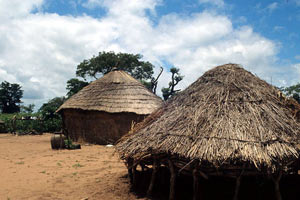 Support to Agricultural Research for Development of Strategic Crops (SARD-SC)
Support to Agricultural Research for Development of Strategic Crops (SARD-SC)The African Development Bank-funded initiative, known as SARD-SC, is a research, science and technology development project targeted at cassava, maize, rice and wheat. These are four of the six commodities that African Heads of States have, via the Comprehensive African Agricultural Development Programme (CAADP), defined as strategic crops for Africa. The specific objective of the project is to enhance the productivity and income of the four CAADP’s priority value chains on a sustainable basis.
The maize project within the SARD-SC aims to “enhance food and nutritional security as well as income of farmers in Ghana, Mali, Nigeria and Zambia with additional spill over to other countries through the development and delivery of improved maize technologies.” The International Institute of Tropical Agriculture (IITA) is the executing agency for the project with partners Africa Rice Center (AfricaRice), the International Food Policy Research Institute (IFPRI) and the International Center for Agricultural Research in the Dry Areas (ICARDA).
Sustainable Intensification of Maize-Legumes Systems in Eastern and Southern Africa (SIMLESA)
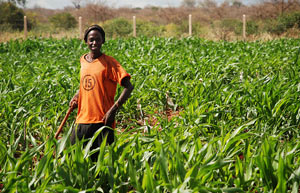 The SIMLESA project is a collaboration between the national agricultural systems in Ethiopia, Kenya, Malawi, Mozambique and Tanzania, and CIMMYT, the International Center for Research in the Semi-Arid Tropics (ICRISAT), the Association for Strengthening Agricultural Research in Eastern and Central Africa (ASARECA), the Queensland Alliance for Agriculture and Food Innovation - University of Queensland (QAAFI-UQ), Murdoch University, the Agricultural Research Council (ARC), and the Australian Government via the Australian Center for International Agricultural Research (ACIAR). Through participatory research and development with farmers, extension agencies, non-governmental organizations, universities and agribusinesses along the value chain, the project aims to improve maize and legume productivity by 30 percent and to reduce the expected downside yield risk by 30 percent on approximately 500,000 farms within 10 years.
The SIMLESA project is a collaboration between the national agricultural systems in Ethiopia, Kenya, Malawi, Mozambique and Tanzania, and CIMMYT, the International Center for Research in the Semi-Arid Tropics (ICRISAT), the Association for Strengthening Agricultural Research in Eastern and Central Africa (ASARECA), the Queensland Alliance for Agriculture and Food Innovation - University of Queensland (QAAFI-UQ), Murdoch University, the Agricultural Research Council (ARC), and the Australian Government via the Australian Center for International Agricultural Research (ACIAR). Through participatory research and development with farmers, extension agencies, non-governmental organizations, universities and agribusinesses along the value chain, the project aims to improve maize and legume productivity by 30 percent and to reduce the expected downside yield risk by 30 percent on approximately 500,000 farms within 10 years.The focal countries of program research are Australia, Botswana, Burundi, Ethiopia, Kenya, Malawi, Mozambique, Rwanda, South Sudan, Tanzania, Uganda, Zambia and Zimbabwe.
Sustainable Intensification of Maize-Legume Cropping Systems for Food Security in Eastern Province of Zambia (SIMLEZA)
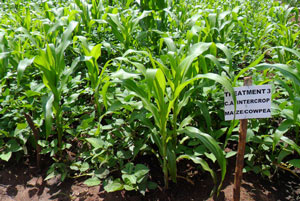 Funded by USAID under the Feed the Future initiative and established in 2011, SIMLEZA is coordinated by CIMMYT and IITA. It aims to intensify maize and legume production by increasing yield through the use of better adapted varieties, by improving crop management and by applying conservation agriculture and biological nitrogen fixation concepts in Zambia's Eastern Province. This project follows the same line of Sustainable intensification of maize-legume systems for food security in Eastern and Southern Africa (SIMLESA). Currently the SIMLEZA project operates in six target communities, but it aims to impact 20,000 households in the Eastern Province by 2014. Other partners are the Zambian Agricultural Research Institute (ZARI), the Ministry of Agriculture, University of Zambia, Total Land Care, Kamano Seeds and Indigenous seeds.
Funded by USAID under the Feed the Future initiative and established in 2011, SIMLEZA is coordinated by CIMMYT and IITA. It aims to intensify maize and legume production by increasing yield through the use of better adapted varieties, by improving crop management and by applying conservation agriculture and biological nitrogen fixation concepts in Zambia's Eastern Province. This project follows the same line of Sustainable intensification of maize-legume systems for food security in Eastern and Southern Africa (SIMLESA). Currently the SIMLEZA project operates in six target communities, but it aims to impact 20,000 households in the Eastern Province by 2014. Other partners are the Zambian Agricultural Research Institute (ZARI), the Ministry of Agriculture, University of Zambia, Total Land Care, Kamano Seeds and Indigenous seeds.Water Efficient Maize for Africa (WEMA)
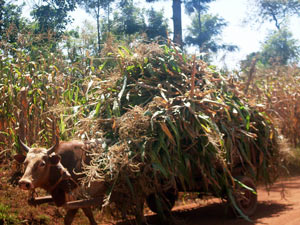 Funded by the Bill & Melinda Gates Foundation and the Howard G. Buffet Foundation, WEMA was launched in March 2008 to help farmers manage the risk of drought by developing and deploying maize varieties that yield 24 to 35 percent more grain under moderate drought conditions than currently available varieties. The higher and more reliable harvests will help farmers to feed their families and increase their incomes.
Funded by the Bill & Melinda Gates Foundation and the Howard G. Buffet Foundation, WEMA was launched in March 2008 to help farmers manage the risk of drought by developing and deploying maize varieties that yield 24 to 35 percent more grain under moderate drought conditions than currently available varieties. The higher and more reliable harvests will help farmers to feed their families and increase their incomes.The varieties are being developed using conventional breeding, marker-assisted breeding, and biotechnology, and will be marketed royalty-free to smallholder farmers in Sub-Saharan Africa through African seed companies. The current, second phase of the project includes breeding for resistance to stem borers - insect pests that seriously damage maize crops in the field - as well as product and production management, promotion with seed companies and farmers and product stewardship activities.
The project focuses on Kenya, Mozambique, South Africa, Tanzania and Uganda.
